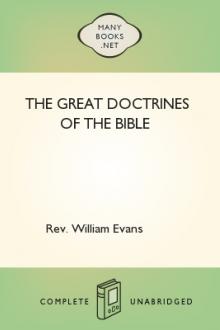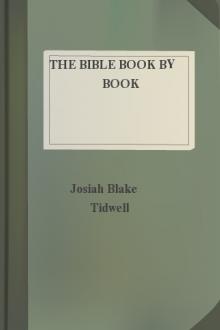The Great Doctrines of the Bible by Rev. William Evans (best books to read for self improvement TXT) 📖

- Author: Rev. William Evans
- Performer: -
Book online «The Great Doctrines of the Bible by Rev. William Evans (best books to read for self improvement TXT) 📖». Author Rev. William Evans
Yet there must be no consciousness of cowardice in proclaiming the doctrine of future retribution, however awful its delineation may be. Fear is a legitimate motive to which we may appeal, and while it may be classed among the lower motives, it is nevertheless true that it is the only motive that will effectively move some people to action.
SOME RECOGNIZED FACTS.
There are certain preliminary facts which should be recognized in the discussion of this subject:
1. That it shall be well with the righteous, and woe to the wicked (Isa. 3:10, 11). That there is to be retribution for sin and a reward for the righteous must be held to be beyond question, and must be recognized as an unchangeable law. One cannot very well meddle with that truth without serious danger. So long as a man persistently, willingly and knowingly continues in his sin he must suffer for it. That suffering the Bible calls eternal death.
2. We must recognize that much of the language of the Scripture dealing with this condition is couched in figurative terms. But the condition is none the less real because of that, for, generally speaking, the reality is more severe than the figure in which it is set forth. Yet we need caution here, and must distinguish between the things that are stated in clear unmistakable language and those that are set forth in words symbolic and figurative.
3. The disparity in the number of saved and lost. There is a danger lest we should be unmindful of the problems connected with this doctrine, such as that seeming fewness of the saved; the condition of the heathen who have not had a chance to hear the Gospel; and the difference in privilege and opportunity among those who live in so-called Christian lands.
4. Prophecy vs. History. We must recognize that it is more difficult to deal with facts which lie in the future than with those lying in the past. Prophecy is always more difficult to deal with than history. The past we may sketch in details, the future but in broad outlines.
“Our treatment of themes that deal with the future must, in the very nature of the case be very different than it would be were we dealing with the things of the past. History and prophecy must be handled differently. In dealing with the history of God’s past revelations—with the ages before the Advent, with the earthly life and revelation of Jesus Christ, with the subsequent course of God’s providence in the Church—we are dealing with that which has already been. It stands in concrete reality before us, and we can reason from it as a thing known in its totality and its details. But when the subject of revelation is that which is yet to be, especially that which is yet to be under forms and conditions of which we have no direct experience, the case is widely altered. Here it is at most outlines that we can look for; and even these outlines will be largely clothed in figure and symbol; the spiritual kernel will seek material investiture to body itself forth; the conditions of the future will require to be presented largely in forms borrowed from known relations. The outstanding thoughts will be sufficiently apparent, but the thoughts in which these thoughts are cast will partake of metaphor and image.”—_James Orr._
II. THE WICKED ARE SAID TO “DIE IN THEIR SINS.”
John 8:21, 24—“Then said Jesus again unto them, I go my way, and ye shall seek me, and shall die in your sins: whither I go, ye cannot come. I said therefore unto you, that ye shall die in your sins: for if ye believe not that I am he, ye shall die in your sins.” Rom. 6:23—“For the wages of sin is death.” See Rev. 20:14,
15; 21:8.
The “death” spoken of here does not mean cessation of existence any more than eternal life means the beginning of existence. Eternal life does not mean merely to live for ever, but to live in a state of blessedness for ever. Eternal life deals not so much with quantity as with quality of existence. Just so with eternal death. It is a quality of existence, not cessation of being. Even in this life death can co-exist with life: “But she that liveth in pleasure is dead while she liveth” (1 Tim. 5:6); Eph. 2:1. What men call life God calls death. There are two things which the believer gets: at his regeneration, eternal life; at his resurrection, immortality; but in both instances he already has life and existence. So it is in the case of the wicked: the second death does not mean cessation of existence, for he is dead already, now in this life (1 Tim. 5:6; Eph. 2:1; John 5:24, 25). Rev. 21:8 describes what “death,” as here used, means: “But the fearful, and the unbelieving… shall have their part in the lake which burneth with fire and brimstone: which is the second death.”
III. THE WICKED ARE NOT ANNIHILATED.
The texts most strongly urged as teaching the annihilation theory, if rightly interpreted, will be seen to refer to removal from off the earth, and not to future retribution. Here are the principal passages:
Psa. 37:20—“But the wicked shall perish, and the enemies of the Lord shall be as the fat of lambs: they shall consume; into smoke shall they consume away.” This psalm is written for the encouragement of Israel and against her enemies and their power on the earth. This earthly power shall be utterly broken, and be of no more account than the smoke of a burnt sacrifice. The great truth taught here is that the earth is the inheritance of the saints, and that the wicked shall have no part in it.
Obadiah 16—” … And they shall be as though they had not been.” These words are taken from the vision regarding Edom, and refer to the destruction of the Edomites and their land, and not to the future of the wicked in the next life.
In speaking of the “everlasting punishment” with which the wicked will be visited, as recorded in 2 Thess. 1:9, the annihilationist would say that reference is made to the “results or consequences” of that punishment and not to the punishment itself. But the Scriptures state that it is the “punishment” itself, and not the consequences, that is everlasting.
No such interpretation as that put upon these passages by those holding the annihilation theory can be maintained by sound exegesis. What need is there of a resurrection if the wicked are to be annihilated at death, or why should they be raised from the dead if only to be at once extinguished for ever? Again, there is no such thing as “unconscious” punishment. You cannot punish anything that is unconscious. Can you punish a stone or a house? Punishment can take place only where there is consciousness on the part of the one suffering.
IV. THE WICKED ARE TO BE PUNISHED.
Rom. 2:8, 9—“But unto them that are contentious, and do not obey the truth, but obey unrighteousness, indignation and wrath, tribulation and anguish, upon every soul of man that doeth evil, of the Jew first, and also of the Gentile.” “Wrath” indicates the settled mind of God towards the persistently wicked (John 3:36); “indignation,” the outbreak of that wrath at the day of judgment; “tribulation,” severe affliction (Matt. 13:21; 24:9; Rev. 7:14); “anguish,” torturing confinement in a strait place without relief, as in a dungeon, or in stocks. God grant that we may never know what these terms fully mean.
Matt. 25:41, 46—“Then shall he say also unto them on the left hand, Depart from me, ye cursed, into everlasting fire, prepared for the devil and his angels. And these shall go away into everlasting punishment.” 2 Thess. 1:7-9—“When the Lord Jesus shall be revealed from heaven with his mighty angels, in flaming fire taking vengeance on them that know not God, and that obey not the gospel of our Lord Jesus Christ: who shall be punished with everlasting destruction from the presence of the Lord, and from the glory of his power.” See also Mark 9:43-50 which speaks of the wicked being cast into “hell, into the fire that never shall be quenched: where their worm dieth not, and the fire is not quenched.”
There are certain important words in these scriptures which demand our attention, and which we need to understand in order to get right views of the doctrine we are now considering. They are as follows:
1. “ETERNAL.”
We read of “eternal” or “everlasting” punishment, “everlasting” fire. It is objected that the word “eternal” or “everlasting” does not mean “forever.” This may be true. But we are all willing to admit that when this word qualifies the condition of the righteous it means for ever, without end, e.g., the righteous shall go “into life eternal.” The same word, however, qualifies the punishment of the wicked, e.g., “these shall go away into everlasting punishment.” Fairness demands that we make the joy of the righteous and the punishment of the wicked—both qualified as they are by the same Greek word—of the same duration. If there is an end to the reward of the righteous, there is also to the penalty of the wicked. The one lasts as long as the other. If “destruction” means annihilation, then there is no need of the word “eternal” to qualify it. Further the Scriptures present the punishment of the wicked not only as “eternal” (or age-long) but as enduring “for ever and ever,” or “unto the ages of the ages” (Rev. 19:3; 20:10; 14:11, R. V.). Here is a picture of ages tumbling upon ages in eternal succession.
2. “PUNISHMENT.”
The meaning of this word will be found under the previous division (III) dealing with the subject of Annihilation.
3. “FIRE.”
This is one of the most constant images under which the torment and misery of the wicked is represented. Fire is a symbol of the divine judgment of wrath (Matt. 5:22). In Matthew 3:10 the godless are represented as a tree hewn down and cast into the fire; in 3:12 the chaff (godless) is burned with unquenchable fire; in 13:42 the wicked are said to be cast into a furnace of fire.
Is the “fire” spoken of here literal fire? It is an accepted law of language that a figure of speech is less intense than the reality. If “fire” is merely a figurative expression, it must stand for some great reality, and if the reality is more intense than the figure, what an awful thing the punishment symbolized by fire must be.
It is contended that fire must necessarily consume; that nothing could continue to exist in fire. Is it not remarkable that the Baptist uses the word “unquenchable”’ (Greek, “asbestos”) when speaking of this fire? Is any light thrown on the question by the incident of the three Hebrew children in the fiery furnace? Did they consume, or did they withstand the fire? (Dan. 3:27). In the parable of the Tares (Matt. 13:36-43) our Lord speaks of the tares being burned up. When Christ retired to the house after delivering the parable, his disciples asked Him to explain to them what He meant by the figures of speech He used in the parable. This request He granted. He explained the figurative language of the parable; every figurative word in it except that of “fire.” He said: “The field is the world; the good seed are the children of





Comments (0)